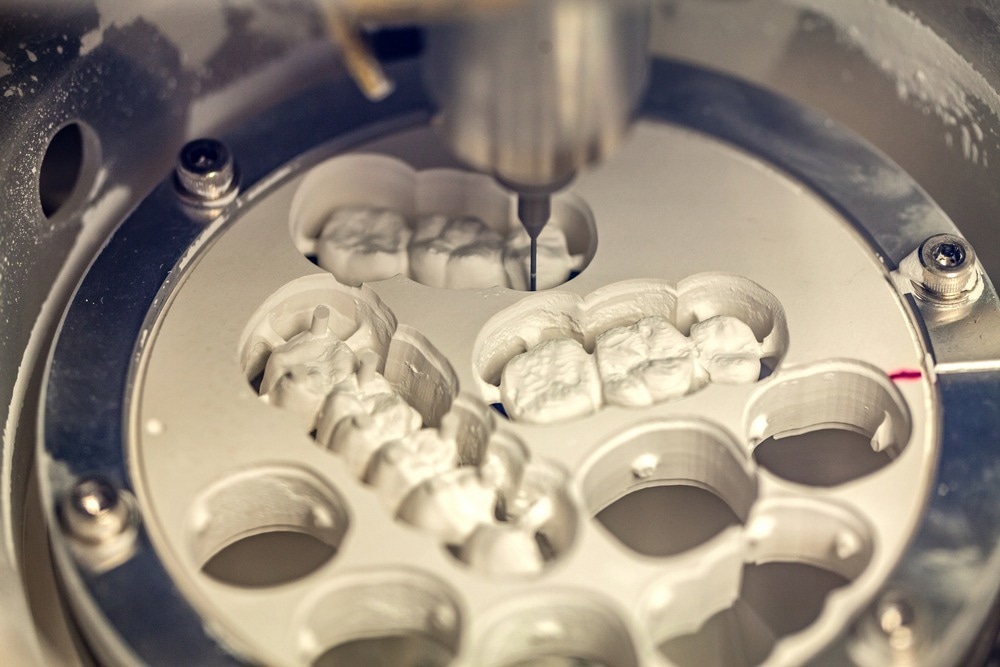 By Surbhi JainReviewed by Susha Cheriyedath, M.Sc.Nov 8 2022
By Surbhi JainReviewed by Susha Cheriyedath, M.Sc.Nov 8 2022In an article recently published in the journal Journal of the European Ceramic Society, researchers discussed the development of fully dense zirconia ceramics printed in three dimensions (3D) by extrusion for dental restorations.

Study: Extrusion-based 3D printing of fully dense zirconia ceramics for dental restorations. Image Credit: Bencemor/Shutterstock.com
Background
Due to its distinctive qualities, zirconia ceramics have drawn growing interest in biomedical applications. Zirconia is challenging to manufacture into a 3D structure with complex geometry due to its extraordinarily high chemical inertness and melting temperature. Subtractive computer-aided manufacturing (sCAM) has become the primary method for creating dental crowns and bridges made of zirconia in the dentistry sector. Although this method is well known and offers several benefits, it also has some drawbacks.
A viable alternative to the limitations of the sCAM technology is 3D printing (3DP). Dental ceramics can be produced using a variety of 3DP processes. The extrusion-based 3DP technique is thought to be the simplest and most economical of these technologies. Initial research has produced encouraging findings of comparable strength and accuracy; however, there are significant problems with this method that prohibit it from being accepted in dentistry. To keep the overhang structure from collapsing, the system typically needs a support strategy. The support materials also need to be simple to remove without contaminating the structural components.
About the Study
In this study, the authors discussed the manufacture of detailed, totally dense ceramics based on gelled zirconia suspensions, and an improved extrusion-based 3D printing technique was created. The suspensions' viscoelastic characteristics were adjusted to provide self-supporting features and a smooth flow through a 150-250 micron nozzle at a high solid volume fraction of 52%. The as-dried zirconia specimens could be directly sintered without the need to remove the binder because of the low organic content.
The team demonstrated that the sintered zirconia ceramics' flexural strength, maximum relative density, and hardness were 1010 MPa, 99.3%, and 15.9 GPa, respectively. By co-printing a unique polyacrylate supporting material that could be removed by cooling due to its temperature-dependent rheological behavior, zirconia dental restorations were created while maintaining the occlusal features. An improved extrusion-based ceramic 3DP technique was created to develop flawless, completely functional ceramics appropriate for dental restorations.
The researchers illustrated that to achieve self-supporting properties, the aqueous suspensions for 3DP, in which ZrO2 functioned as the ceramic phase, were designed with low organic binder content and high solid loading. Additionally, a brand-new polyacrylate (PAA) gelled suspension-based freeze-removable supporting material system was created. Both suspensions' rheological characteristics and the ZrO2 suspension's suitability for 3D printing were examined. The mechanical characteristics of the sintered samples under various sintering conditions were characterized after the green bodies of the samples were constructed. Dental crown and tooth samples were made to confirm the process's viability.
Observations
To properly produce delicate parts with overhangs, the support was one of the most crucial components. Based on a gelled PAA suspension, a new freeze-removable supporting material scheme was created. This suspension exhibited temperature-dependent rheological characteristics and served as a supportive substance in this procedure. Thus, cooling made it simple to remove the support.
Both zirconia and PAA suspensions could be 3D printed without difficulty using the proposed technique. Due to the extremely low organic binder fraction, the as-dried zirconia samples could be sintered without the need for binder removal processes. The sintered zirconia specimens had 1010 MPa of flexural strength, maximum relative densities of 99.3%, and 15.9 GPa of hardness. The information demonstrated that the proposed method could create ceramics made of totally thick ZrO2.
Additionally, dental crowns with a gradient in color and translucency could be produced without time-consuming post-processing if the right ZrO2 suspensions with different colorants or transparency modifiers were synthesized and blended before extrusion. However, the milling method continued to be superior to this extrusion-based ceramic 3DP technology. Printing was extremely sluggish, and the surface roughness was unacceptable.
Conclusions
In conclusion, this study elucidated the development of a 3DP technique based on optimized extrusion for gelled zirconia suspensions. The suspension's viscoelastic characteristics were adjusted to form self-supporting features and enabled flow via a 0.15-0.25 mm nozzle at a high solid-volume percentage. The ZrO2 suspension was extruded using an eccentric screw dispenser that was extremely precise. To show how the proposed approach could produce dental restorations with a complex geometry when used with the PAA support, ZrO2 tooth and dental crown fabrication were conducted.
The authors mentioned that the aforementioned characteristics provided good process accuracy for creating complex ceramic structures. They also stated that a new path has been opened for the fabrication of flawless, totally dense dental restorations with comparatively high accuracy thanks to the special compositions of the gelled ZrO2 and PAA suspensions and the insight afforded by the impacts of the facility and parameters on the process precision.
The team believes that it is essential to continue researching optimization techniques to raise the accuracy and efficiency of production.
More from AZoM: How are Bioplastics Made?
References
Jiaxiao, S., Xie, B., Zicai, Z., Extrusion-based 3D printing of fully dense zirconia ceramics for dental restorations. Journal of the European Ceramic Society (2022). https://www.sciencedirect.com/science/article/abs/pii/S095522192200855X
Disclaimer: The views expressed here are those of the author expressed in their private capacity and do not necessarily represent the views of AZoM.com Limited T/A AZoNetwork the owner and operator of this website. This disclaimer forms part of the Terms and conditions of use of this website.